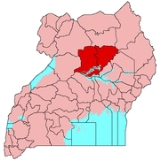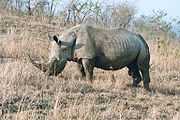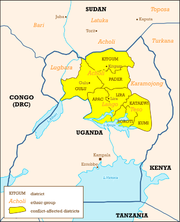
Lango
Encyclopedia
Lango of Uganda
The Lango or Jo Lango (Lango people) live in the Lango sub-region (politically Northern RegionNorthern Region, Uganda
Northern Region is a region of Uganda. It is divided into the following districts:...
, but geographically central Uganda), north of Lake Kyoga
Lake Kyoga
Lake Kyoga is a large shallow lake complex of Uganda, about in area and at an elevation of 914 m. The Victoria Nile flows through the lake on its way from Lake Victoria to Lake Albert. The main inflow from Lake Victoria is regulated by the Nalubaale Power Station in Jinja. Another source of water...
. Lango sub-region comprises the districts of Amolatar
Amolatar District
Amolatar District is a district in Northern Uganda. Like most Ugandan districts, it is named after its 'chief town', Amolatar, where the district headquarters are located.-Location:...
, Alebtong
Alebtong
Alebtong, sometimes spelled Alebtongo, is a town in Northern Uganda. It is the chief municipal, administrative and commercial centre of Alebtong District. The district is named after the town.-Location:...
, Apac
Apac District
Apac District is a district in Northern Uganda. Like most other Ugandan districts, it is named after its 'chief town', Apac, where the district headquarters are located...
, Dokolo
Dokolo District
Dokolo District is a district in Northern Uganda. Like most Ugandan districts, it is named after its 'chief town', Dokolo, where the district headquarters are located.-Location:...
, Kole
Kole District
Kole District is a district in Northern Uganda. Like most other Ugandan districts, it is named after its 'chief town', Kole, where the district headquarters are located.-Location:...
, Lira
Lira District
Lira District is a district in Northern Uganda. Like many other Ugandan districts, it is named after its 'chief town', Lira.-Location:Lira District is bordered by Pader District to the north, Otuke District to the northeast, Alebtong District to the east, Dokolo District to the southeast, Apac...
, Oyam
Oyam District
Oyam District is a district in Northern Uganda. Like most Ugandan districts, it is named after its 'chief town', Oyam, where the district headquarters are located.-Location:...
, and Otuke
Otuke District
Otuke District is a district in Northern Uganda. Like most other Ugandan districts, it is named after its 'chief town', Otuke, where the district headquarters are located.-Location:...
. The Lango population is about 1.5 million according to the 2002 population census.
Lango will be used in the text instead of "Langi". Driberg used Lango, not "Langi" in his study "The Lango: A Nilotic Tribe of Uganda (1923)." Kihangire (1957), interviewed Lango elders for his dissertation, and "Langi" is not mentioned in the text, but Lango or Lango people. In addition, anthropologists and explorers who traveled the "Lango country (Uganda)" used Lango nation, Lango country, and Lango people to refer to "Lango people (Uganda)". Tosh (1978) states "until very recently, Lango was used indiscriminately in the ethnographic literature, and it appears that Langi is a relatively recent form." The word “tribe” is foreign, and there is no Lango word for “tribe”, so tribe will not be used in the text except ones in quotations.
History

Luo languages
The Nilotic Luo languages, or Lwoian, are a dozen languages spoken by the Luo peoples in an area ranging from southern Sudan via Uganda to southern Kenya, with Dholuo extending into northern Tanzania and Alur into the Democratic Republic of the Congo. They form one of the two branches of Western...
) language like their northern Acholi and Alur neighbours, but share some clan names with the Ateker
Ateker
Ateker or Atekerin is a common name for the closely related Jie, Karamojong, Turkana, Toposa, Nyangatom and Teso peoples and their languages. Itung'a and Teso have been used among ethnographers, while the term Teso-Turkana is sometimes used for the languages, which are of Eastern Nilotic stock....
people. The Lango identify with the Luo speaking people, refuting the theory that they are Ateker. One possible explanation, the Ateker clans were overpowered or sought protection from the Lango warriors and were assimilated. According to Driberg (1923), Lango reached eastern province of Uganda (Otuke Hills) having traveled southeasterly from the Shilluk area, and that Lango language is similar with that of the Shilluk language
Shilluk language
The Shilluk Language, or Chollo, is a Nilotic language spoken by the Shilluk people of South Sudan. It is closely related to Luo. Dhɔg Cɔllɔ is widely spoken throughout the Shilluk Kingdom and it is the official language of Shilluk and the residents in Shilluk Kingdom.-Written language:Tyɛlli...
. Driberg (1923) described Lango as superior people, sensible, with a distaste for witchcraft, high morality, brave and venturesome warriors, hardworking people, individualistic, independent and impatient of control (pg. 69). He experienced the latter as a colonial administrator in Lango.
Driberg's (1923) physical description of the Lango is colorful, "the Lango are long-limbed, orthognathous and dark skinned. They have narrow jaw as a rule, and their lips are much thinner and their nose better formed than is usual among the negro tribes. They are thin without the lanky appearance which characterizes the Acholi and Dinka
Dinka
The Dinka is an ethnic group inhabiting the Bahr el Ghazal region of the Nile basin, Jonglei and parts of southern Kordufan and Upper Nile regions. They are mainly agro-pastoral people, relying on cattle herding at riverside camps in the dry season and growing millet and other varieties of grains ...
and muscular without any disproportionate development. In contrast with the practice of Bantu
Bantu
Bantu is used as a general label for 300-600 ethnic groups in Africa of speakers of Bantu languages, distributed from Cameroon east across Central Africa and Eastern Africa to Southern Africa...
tribes, the men do all the hard work of cultivation, and this together with the pursuit of hunting and fighting has resulted in a fine appearance of physical capacity, which is not belied by their powers of endurance and sustained exercise. One of the remarkable results of their energetic life is the excessive development of the iliac line...The Lango may with justice be called a handsome race, both men and women, though very degraded-looking specimens are occasionally to be found with more negroid features...It has been observed that they are dark-skinned, but reference should be made to the fact that there live at Apach for some obscure reason a number of much lighter-skinned Lango, and elsewhere the light-skinned type may occasionally be seen" (pg. 50).
Many scholars and anthropologists agree that Lango traveled southeasterly direction from the Shilluk area, and settled somewhere in the east (Otuke Hills) where Lango met the Ateker speaking group and Luo before moving to their present home. The movement fits the Luo mythology where Luo and Lango were neighbors somewhere in the east (Otuke Hills). According to the Luo mythology “Lwanda Magara” Lango and Luo were neighbors, and there were several wars and raids between the two, but also marriages between the two groups. The Luo warrior "Lwanda Magara" himself married many Lango women. When Lango arrived to their present home, they were already speaking a language close and related to other Luo languages
Luo languages
The Nilotic Luo languages, or Lwoian, are a dozen languages spoken by the Luo peoples in an area ranging from southern Sudan via Uganda to southern Kenya, with Dholuo extending into northern Tanzania and Alur into the Democratic Republic of the Congo. They form one of the two branches of Western...
. The south easterly movement of Lango from Ethiopia to their present home also fits the Shilluk mythology where Nyakango and his followers traveled up North after Nyikango separated from Dimo, and the other Luo peoples in wic pac, somewhere in Bahr el Ghazal. There is no mythology about the origin of Lango origin except oral history that they came from the east from “Got Otuke” (Otuke Hills).
Similarities between Lango and Shilluk
1) The Shilluk military commander emerges by virtues of military powers and valour but has no administrative functions or authority just like Lango military.2) The Lango paramount chief has under his authority clan chiefs (jagi), similar to Shilluk political organization.
3) The Shilluk and Lango are monolithic and believe in the Supreme Being (Jwok) Shilluk and (Jok) Lango who lives in the sky where people do no evil. Lango marriage, birth, naming, initiation to adulthood, death and religion/beliefs are similar to the Shilluk people (Gurtong Homepage, Kihangire 1957).
Government
Lango people had a functional government before the British rule. Lango cultural government consist of Jago (English?), Rwot (Clan Chief), Awitong (English?), and Won Nyaci (Paramount Chief). The British government was aware of this, and used the counsel of these head of clans when they wanted something done. In Lango, there was no hereditary king or supreme chief as practiced in Buganda or Bunyoro. The Lango government system was through elected clan chiefs with authority over the people of their clans. Chiefs were hereditary in some clans, so when a Chief (Rwot) dies, elders from the clan would choose one of the child (son) to succeed him, (Kihangire, p.21).Military
Driberg described the Lango as "brave and venturesome warriors who have won fear and respect of their neighbors..." (pg.68). The Lango army was united under one military leader chosen from the war able men, and all must agree to be led by him. These military leaders would lead Lango army against other groups. Their authority ends when the war is over, and they all return to their clans and resume their daily occupation, and were not entitled to any special benefits. Famous military leaders were: Ongora Okubal who brought Lango to the present land, Opyene Nyakonyolo who succeeded Ongora Okubal, and was followed by Arim Oroba and Agoro Abwango. Agoro Abwango lead his men to fight the Banyoro and was killed in Bunyoro, (Kihangire, p.22).Education
The pre-colonial education were both formal and informal. Children are taught morality and how to address their relatives and respect other people by their mother or siblings. When they get older, boys are taught by father or male relatives, and girls by mother or female relatives. Games, folk stories, myths, proverbs, and riddles play very important role in Lango education. In addition to mimicking adults, children games foster a sense of domestic responsibility. The proverbs contain moral and social maxims, and riddles stimulate the activity of the mind, (Kihangire, 26).Land Tenure
Land in pre-colonial era was common land, and any untilled area belongs to the first person or family who tills it, and is passed on to sons. According to Kigangire, "land which had not been cultivated in the past could be tilled by any family, and, when once it had been tilled, the community regarded it as the property of the family whose ancestor first cultivated it." (Kihangire, p. 22). The traditional land tenure is still widely used in rural areas.Political violence
Lango have often been victims of the volatile politics of Uganda. The first Ugandan prime minister and two time president, Milton OboteMilton Obote
Apolo Milton Obote , Prime Minister of Uganda from 1962 to 1966 and President of Uganda from 1966 to 1971, then again from 1980 to 1985. He was a Ugandan political leader who led Uganda towards independence from the British colonial administration in 1962.He was overthrown by Idi Amin in 1971, but...
, was a Lango. During the 1970s, state-inspired violence by the government of Idi Amin
Idi Amin
Idi Amin Dada was a military leader and President of Uganda from 1971 to 1979. Amin joined the British colonial regiment, the King's African Rifles in 1946. Eventually he held the rank of Major General in the post-colonial Ugandan Army and became its Commander before seizing power in the military...
was used to decimate the elite of the Lango and their neighbours the Acholi. The 19-year-old war between the government of Uganda and the Lord's Resistance Army
Lord's Resistance Army
The Lord's Resistance Army insurgency is an ongoing guerrilla campaign waged since 1987 by the Lord's Resistance Army rebel group, operating mainly in northern Uganda, but also in South Sudan and eastern Democratic Republic of the Congo...
(LRA) is behind a massive population displacement in the region.


